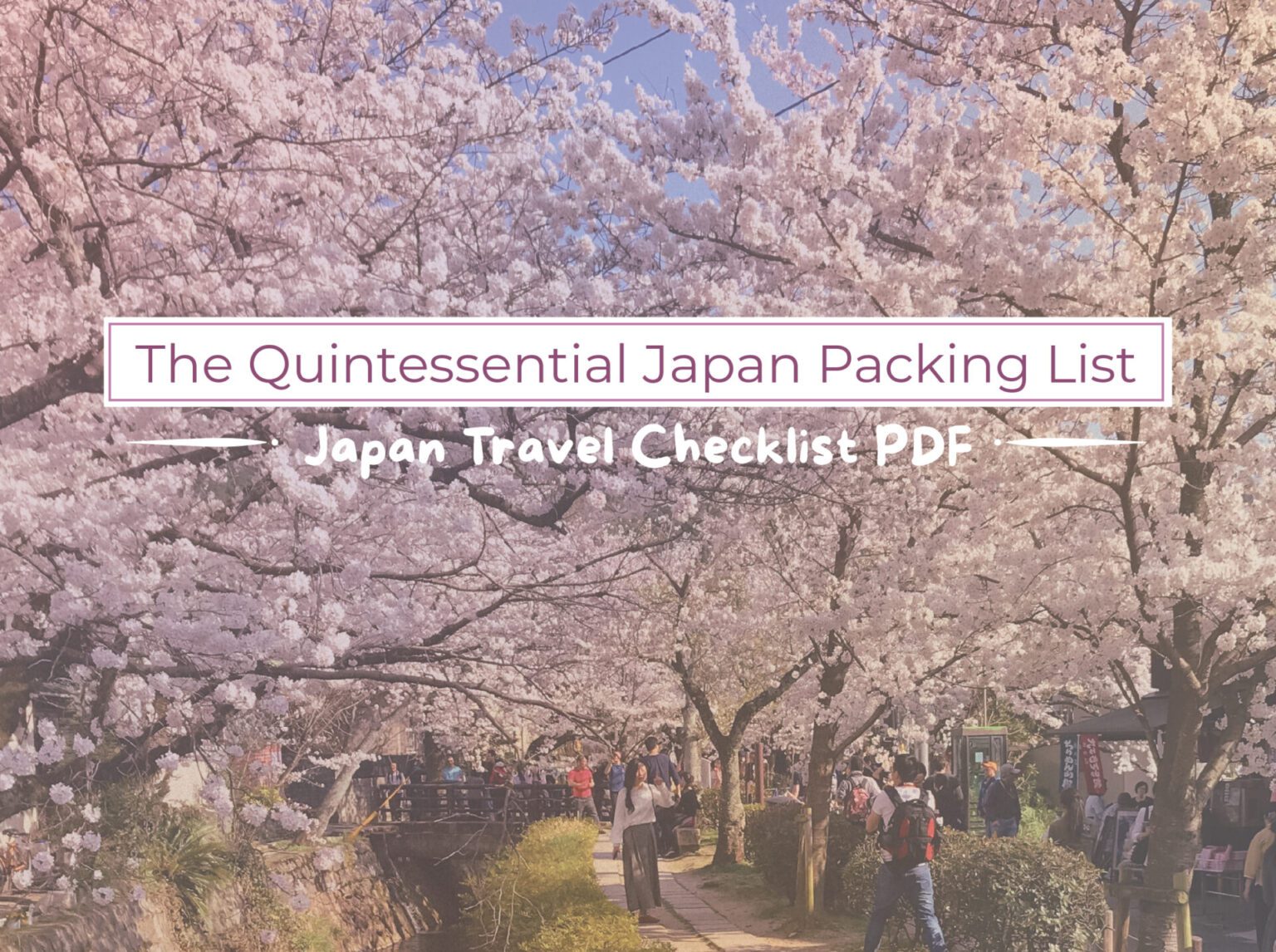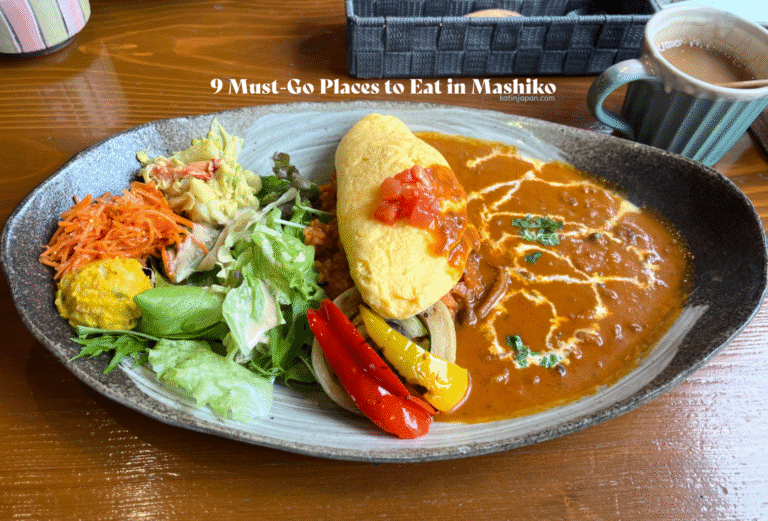Knowing just what to pack for your Japan trip can be a headache, but with my handy packing list and a few key tips you’ll be packed in no time.
I always find packing to be a double-edged sword. Exciting yet impossible to pick the essentials.
But after traveling to Japan, Korea, Montreal, Taiwan, and Bali, I finally feel qualified to offer my advice. For me, packing is like writing. Put everything you want to pack in the case, then edit it down.
But this approach does come at a higher time-cost. So when you just want to pack efficiently, quickly, and thoroughly, check out my Quintessential Japan Packing List! (Free downloadable PDF below)
Packing for your Japan Trip
I’ve been to Japan three times: once as a tourist in 2014, and twice to live here. When you take this into account, plus traveling around Asia and America, I’ve picked up some handy tricks for packing.
One thing is for sure though – you have to pack for your own preferences. For example, I’m picky about keeping a lotion and chapstick in my personal bag when flying. I also run cold and always need a sweater.
The same may not apply to you, so edit where you can, and pack only what you need, while remembering the essentials.
And if you need a day-bag checklist, check out my What’s in my Bag – Daily Essentials in Japan blog for a free PDF.
First and foremost:
Pack light; as light as you can – I personally recommend only bringing a carry-on to Japan if you can manage it!
This will give you the best mobility and most potential for bringing back lots of souvenirs if you want to. Plus, hotels in Japan are tiny. Trying to fit huge luggage into a business hotel isn’t fun.
Of course, both carry-on and checked bags have their merits and demerits, but ultimately it’s up to you.
I’ll split my tips into checked bags and carry-ons only. Then a breakdown of the types of clothing to bring per season.
Download the Quintessential Japan Packing List PDF

Join the Kat in Japan Newsletter and gain access to the high-resolution Quintessential Japan Packing List PDF!
And the Japan Travel Guide Checklist – FREE!
Carry-on Only Tips
Whether taking a soft- or hard-sided luggage, make sure it has omni-directional wheels. You’ll thank me later.
And on the topic of luggage, you may want to pack an additional, empty duffel bag inside for your return trip. (For all those souvenirs).
Otherwise, I recommend a backpack for your personal item, with plenty of space for your electronics, snacks, and comfort items.

Depending on how long you stay, taking only a carry-on can provide better mobility. And if you have a layover, it can prevent you from being late to your connection.
Your willingness to go to a laundromat or get your clothes laundered at a hotel is also a factor. You can get away with less clothing if you can wash your clothes, but it will take some precious travel time.
Different seasons and weather conditions also affect carry-on effectiveness; heavy coats and boots make traveling light more difficult.
Carry-on
1. My rule of thumb is to pack enough shirts/dresses for the amount of days you’re staying (unless you want to do laundry).
2. Plan to re-wear sweaters, only pack one to two.
3. Pack one to two pairs of sturdy or flowy bottoms that can be reworn (ie. jeans, cargo pants, or wide-leg pants, sturdy skirt).
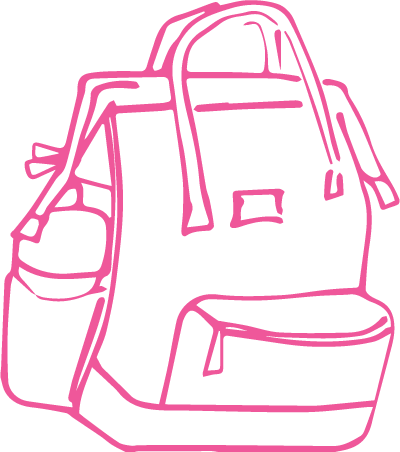
4. And a set of simple pajamas (can be a t-shirt and sweats).
5. Plus enough socks and underwear plus two.
6. Anything extra you deem necessary.
Tip: pack a small tote bag inside in case you end up with extra snacks, etc. for while you’re out.
Personal Item
Whether this is a purse, fanny pack, or backpack, make sure your tech/media, chargers, headphones, and snacks/water are in this bag.
*Medicine and Prescriptions: just bring what you need. Recommended: dramamine, tylenol, allergy medicine, prescriptions.
Keep your chapstick and lotion, toiletries in this bag for easy access on the plane.
Attach items like headphone cases and neck pillows to the outside of your personal item with carabiners to make room inside.
*Check that your medications are allowed in Japan. Some medications are illegal, and if you bring a large quantity, may require a Yunyu Kakuninsho (Import Confirmation Document).
Packing for Each Season
Spring
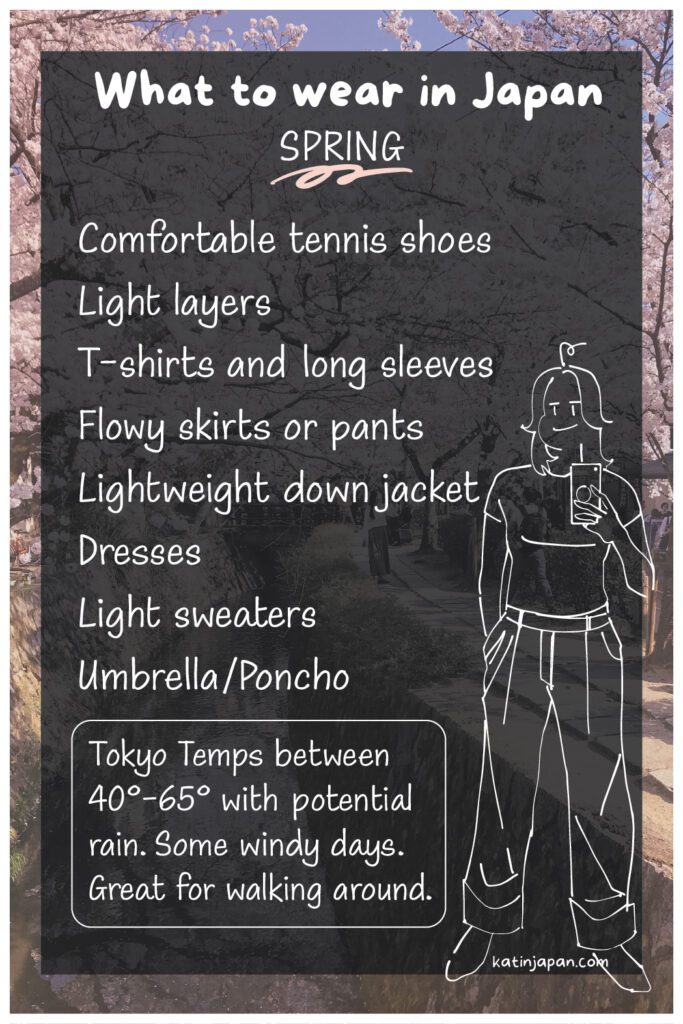
For any travel, it’s crucial to consider the weather both at your starting location and arrival destination.
In Spring and Fall this is less of an issue, but in Summer and Winter you definitely want to be prepared.
Speaking of Spring, aside from the gorgeous Sakura blooming, the weather is simply gorgeous for sightseeing.
It’s balmy in the sun, but the windy and rainy days are great for light sweaters and jeans. I personally like to keep a down jacket on standby for the cooler evenings.
I recommend breathable, comfy tennis shoes for long walks and hanami. It’s also the perfect weather for trying kimono.
Summer
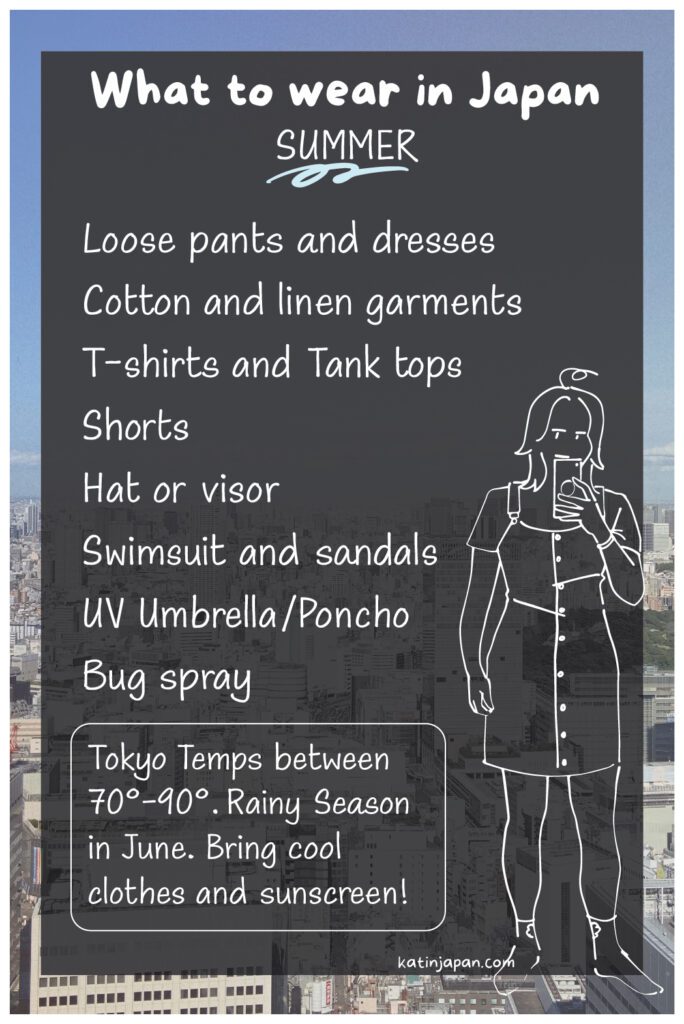
In the Summer, it gets so humid and sweaty that you’ll want to bring several clean shirts – at least one for each day. And be sure to pack extra socks and underwear too.
Whereas in Winter you can get away with re-wearing shirts, you simply won’t want to in the Summer.
Also, people tend to dress more modestly in Japan, with plenty of lightweight, sweat-wicking layers.
It doesn’t mean you have to match their style, but the breathable coverage helps prevent UV exposure and ensures airflow.
If you like wearing sandals though, keep a pair of socks in your day-bag if you plan on touring any shrine or temple interiors.
And if you’re looking into working in Japan, you can check out my What to Wear as an ALT in the Summer post!
Autumn
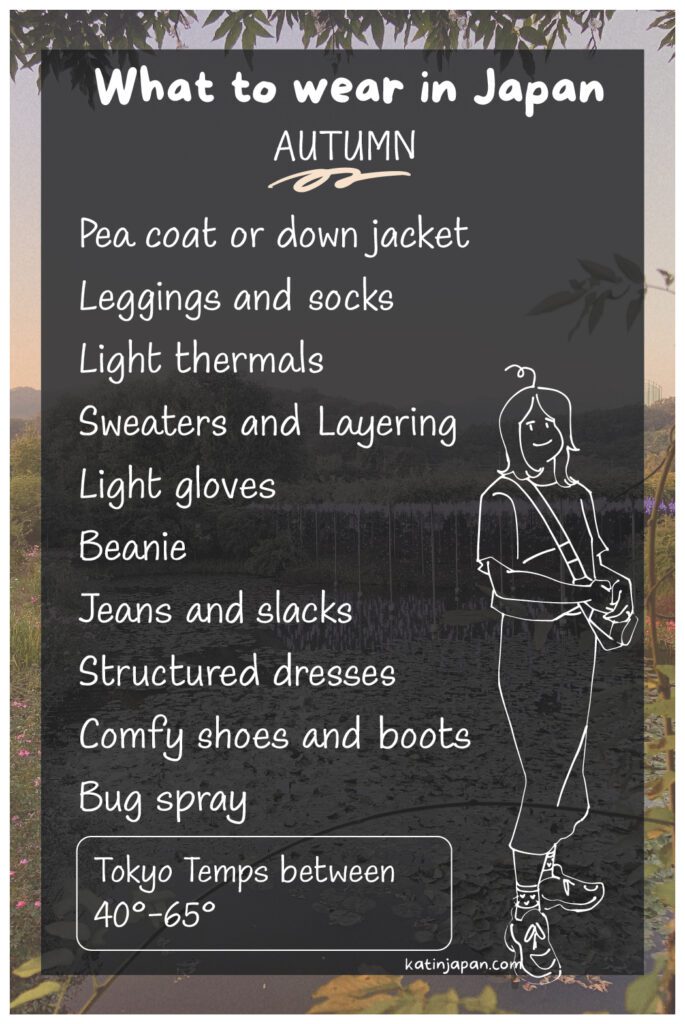
Fall is one of my favorite times of the year in Japan. The changing leaves and cool weather speaks to me even more than Spring.
It’s also the perfect time to break out wardrobe classics like leggings and pea coats or trench coats. You get to feel elegant without being sticky and uncomfortable.
If you bring structured coats or dresses however, try to wear bulkier items on the plane and utilize layering to your advantage.
You may decide to hike amongst the fall leaves, so make sure to have good hiking shoes and long socks to avoid bug bites.
And bug spray is a must since mosquitoes are still hanging around from Summer.
Winter
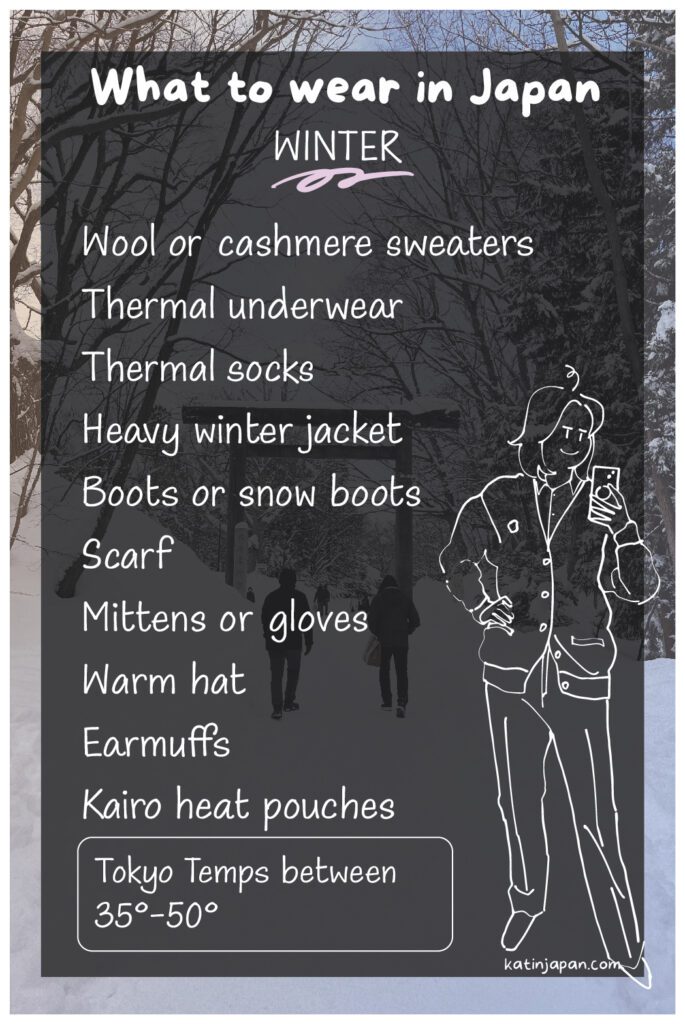
If you know you’re traveling to a cold or snowy area, wear your large jacket and heavy boots on the plane and chuck the jacket in the carry-on bin.
If you forget a piece of clothing like a raincoat or hat, Japan is a fashionable place and has tons of malls and shops you can buy clothes at if you’re in a pinch.
However, if you have big feet or a wide frame, Japan doesn’t have great size-inclusivity. Anything over a men’s size 10 US shoe will be tough to find.
And don’t be afraid to layer up and look like a marshmallow – especially if you travel to northern Japan. There’s no shame in being warm.
Checked Bag Tips
If you insist on bringing checked baggage, I recommend a medium suitcase to make it easier on yourself while traveling.
There are oodles of stairs in Tokyo, especially in the stations – not all of which have good accessibility or elevators. And using the escalators with luggage can still be a hassle.
However, if you plan to utilize a service like Yamato’s luggage delivery service, you can potentially bring as much luggage as you want.
They’ll ship your luggage from the airport to your hotel. But keep an eye on how long it will take to ship.

Also keep in mind most Japanese hotels are fairly compact, so there are limits to where you can store and rummage through your luggage.
You can bring a large luggage and nest a medium luggage inside if you want, but it will add to the complexity of your trip, so I only recommend this if you’ll have a ton of souvenirs to bring home.
With larger luggage, you can pack more clothing like extra pairs of pants, skirts, sweaters, and shoes. I still recommend you keep them to a minimum to stay under 50lbs and make room for souvenirs.
If you’re wondering about some ways to save money on your trip, check out my Ultimate Guide to Traveling on a Budget in Japan!
Study Abroad Packing Tips
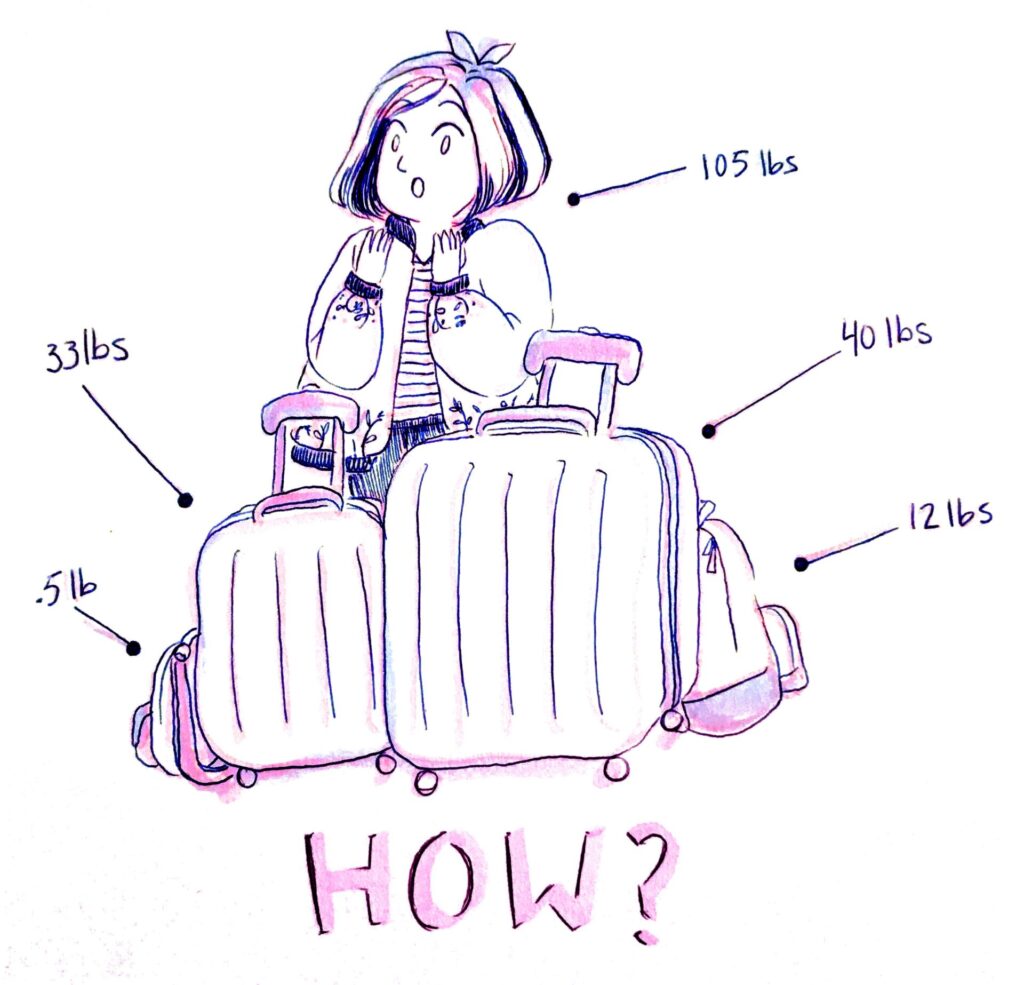
Packing for study abroad is a very different ball game.
When I packed my suitcases, I took 2 weeks’ worth of clothes.
While it was an appropriate amount, I was hopelessly unprepared for how humid and hot the weather gets in Japan. My three day layover in Taiwan was even hotter.
I wore the same pair of wide-legged pants everyday I was in Taiwan because jeans were too atrocious in the heat.
I also recommend against bringing too many clothes since you’ll inevitably need/want to buy them in-country.
The two best things I brought were hands-down my doc martens and the wide-leg pants (see below).
As a California girly, I had to buy my large winter jacket there, since my light down jacket was no use against the Winter weather.
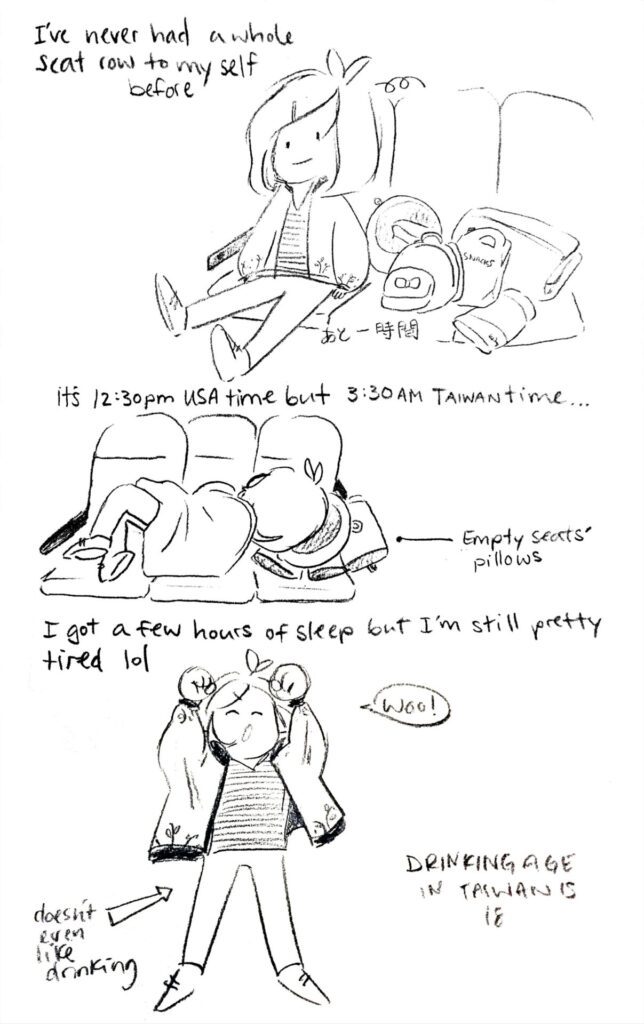
The biggest “mistake” I made when packing for my year abroad was bringing too many art supplies.
I was anxious whether I would make friends, and thought I’d need lots of ar supplies. This was probably my most ridiculous concern.
Even if I hadn’t managed to make lifelong friends there, I would have spent more time outside exploring anyway. And I had my drawing tablet, so I could’ve easily left out my various colored pencils, copics, and paints.
So try to only bring the basics – toiletries, medications, 2 weeks’ worth of clothes, electronics, and of course your documents and cash.
I do recommend bringing the following:
- For large or wide shoe-needers:
- A pair of dress shoes
- Sneakers (2 pairs)
- Boots (with good tread)
- For people who need larger clothes
- Basic underclothes and underwear for the year
- Fancy or dressy clothes like a suit or nice blouses, dresses
- Everyday basics
- Warm, heavy jacket for winter
- Deodorant
- The deodorant/antiperspirant they sell here may not be up to standards for you. Bring your own or try your luck!
- Toothbrush/toothpaste
- Many of the toothbrushes in Japan have smaller heads.
- Menstrual Hygiene Products
- Bring pads/tampons of your choice. Of course you can get them in Japan, but they might be different from your norm.
- Bring period underwear. Uniqlo and other retailers have started selling their own.
- Some Don Quijote’s sell period cups and discs if you prefer. (Also online retailers).
- Prescriptions/Birth control
- You can bring these with a Yunyu Shomeisho, but again, confirm what drugs you’re allowed to bring in the country.
- You can also get a pill prescription in Japan, but you’ll have to go to the clinic and they have less birth control options.
- Hot sauce, hot cheetos, snacks from your country
- Use these as barter items or just enjoy them. Japan doesn’t have hot sauces like Tapatio, Valentina, or Cholula.
- These are great omiyage and gifts for friends and mentors.
My “Qualifications”
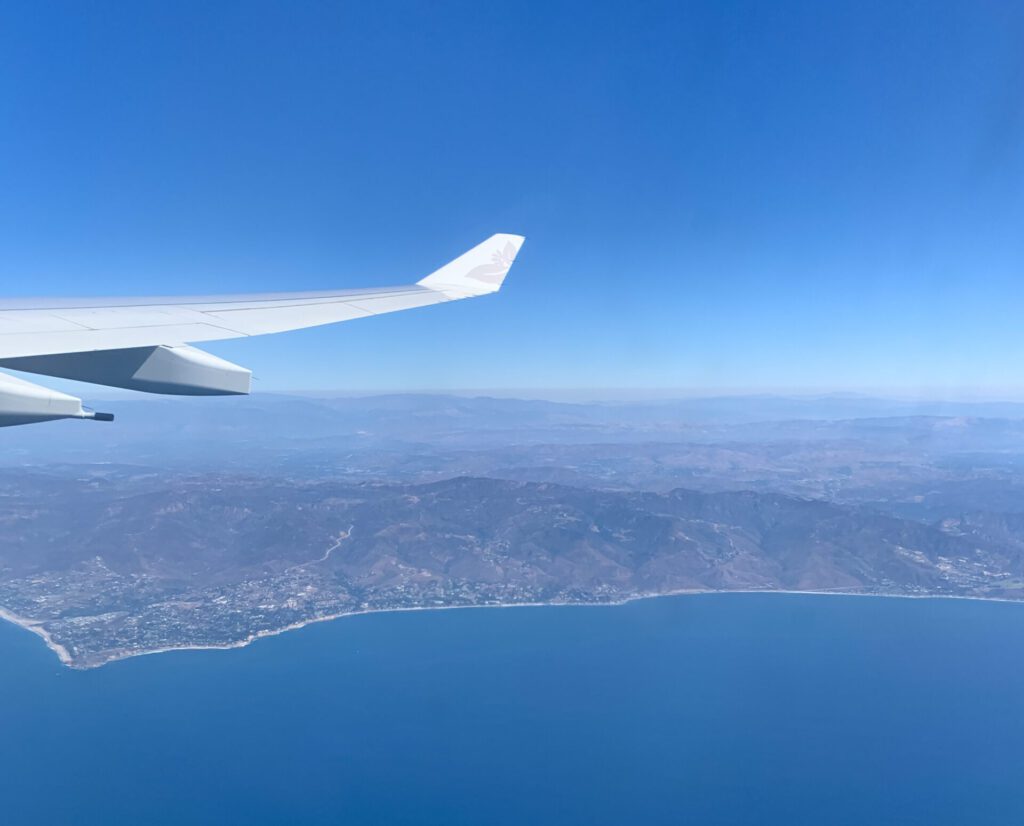
Lastly, I feel qualified to talk about my Quintessential Japan Packing List since I’ve traveled often in the last 8 or so years (except during covid).
I’ve traveled to Japan on a few different occasions with different baggage considerations each time.
The first time, I was vacationing there on a group trip run by my high school Japanese teacher.
It was a 10 day trip, and we hit Tokyo, Kyoto, and Hiroshima. For this trip we only had carry-on luggage.
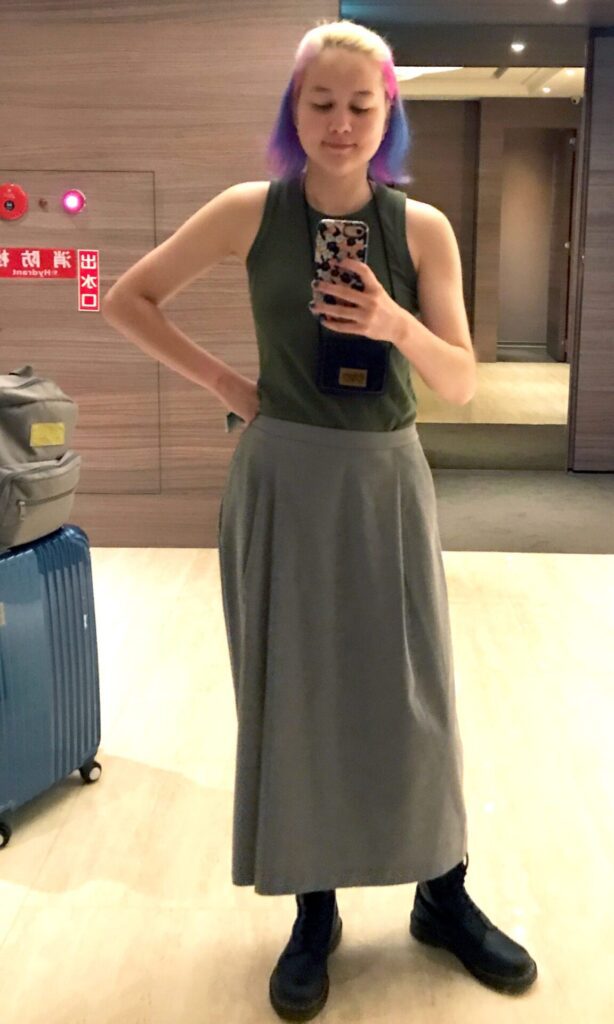
That was my first time flying internationally, and so much has changed about my packing ethos since then.
I packed the essentials in a red, soft-sided suitcase and brought a mini backpack for my personal item. I can recall the airport and airplane food, but not much else of the flight itself.
After landing and going through immigration, we exchanged our cash at Narita Airport, and hopped on the train towards our stay in Shin-Koiwa.
It was a great trip, and maybe I’ll write all about it some other time, but one thing that sticks out to me in this context was my luggage.
It was unfortunately not the sturdiest build, and about 4 days into our trip, its handle couldn’t take anymore pulling around the Tokyo streets and trains. It broke.
It only had single-direction wheels, making it a complete nightmare to lug around. And we even jerry-rigged it with duct tape and an umbrella handle at one point.
Bottom line is: buy a really sturdy, omnidirectional wheel suitcase. Whether it’s hard or soft-sided is up to you.
Then, when I flew to Japan for my study abroad year, I fumbled what I packed.
I managed to get everything I thought I’d need into both a small and medium suitcase, plus a backpack.
However, I packed art supplies that went unused for the majority of the year.
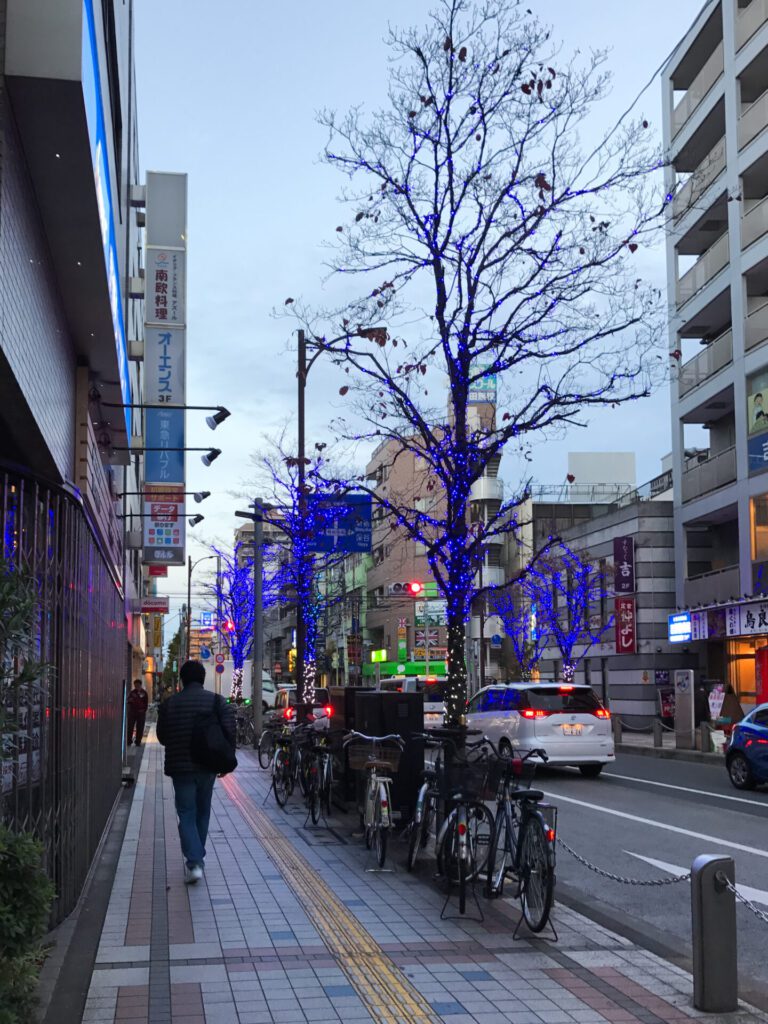
All in all, I would pack less if I were to pack for a one-year trip again.
Especially because fitting everything back into the suitcases plus a duffel bag at the end of that time was tight, and didn’t even include the 3 boxes I shipped back to the US at the end.
And between moving countries twice in the last couple of years, and becoming a more conscientious traveler, I have accumulated lots of packing know-how.
Anyway, whether you’re coming to Japan for the first or third time, I hope this helps. And if you need any ideas on where to go, check out my 7 Must-Go Places in Ginza. Happy Travels!

